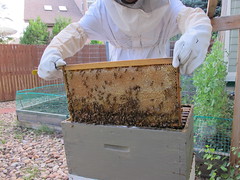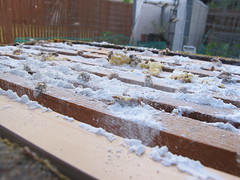I pulled my sticky board from the screened bottom board and found that there were a pretty good number of mites stuck to it, so I knew I wanted to treat the girls with more of the powdered sugar. (You can see them in the close up of the corners, they're pretty thick). I'll probably stick to that for most of the summer, and after all the honey supers come off, I'll probably treat with a miticide in the late fall.
Still, the girls were going strong, and I wanted to see where they were. Also, the top of my two deep brood boxes was filled with old frames that had wood that was starting to come apart. So I wanted to swap out some of the old frames for new ones and move the frames with brood still in them more to the edge so that I could, eventually, take them out, too. A long, slow process, but I figured I'd start by pulling one of the honey-filled frames in that box and substitute in a new frame.
I also wanted to see how they were doing with the new super, how far they'd gotten. The last time I'd looked, they'd only started building comb in the box. I had had a queen excluder between the brood box and the supers, but I pulled it out in impatience during the last inspection, as last year the queen hadn't left the established brood chamber at all, so I hoped that she wouldn't this year either.
I was well rewarded with my hope.
This is the top of the super, right as I went in. If you look closely, you can see that the tops of five of the eight central frames are *capped* honeycomb, i.e. the bees had filled them, dried them enough so that they can't spoil, and then capped them. Capped honey is always dense enough to last on its own. The surprising thing, for me, was that this whole box was empty at the end of May, so in just a little over three weeks, they've more than half filled this box!!
I was pretty amazed. Last year, when the bees first came and were establishing themselves, they had managed to fill three-quarters of one brood box by this time, and there wasn't even the thought of supers or honey that I could harvest at the this point, but it was pretty clear that they were doing really well right now. One of the keepers on the local email lists had said that the local yellow clover was going crazy with the unusually damp spring, so that we should all expect a lot of nectar flow. I still hadn't quite expected *this*.
I still took off the top box, and found that even a medium, eight-frame super is pretty heavy when it's nearly full. The deep box, when full, was impossible for me to move, but I found that this was actually quite doable! I was happy with my choice to go to medium supers instead of using the old deeps. I then went into the brood box to take one of the old frames out, so that I could replace it with a new one. I should probably have moved the damaged one to the edge. Usually the queen doesn't lay in the edge frames, but the baby bees would have the time and support needed to hatch out. Then I could have removed *that* one.
I'll probably do the shift the next time I go into the brood box, but it's good to just get the frame in. A local keeper had just done a study where he found that the keepers that just left all the old brood comb and frames in the box were less likely to have a die off than those that regularly circulated out old frames. It was a correlation, not causation, so he doesn't know why the die offs were less with old comb. Just that those with those tendencies had those results. So I'm unlikely to switch out a lot. And thinking it through some more I probably should have just worked to swap out the broken frame. Next time...
Still... this time I stole a bit more honey, and hopefully made a bit more room for the bees to fill in the brood box. They don't seem in any more of a situation where they will swarm, so this should just help that.
Next, to treat for the mites, I sprinkled sifted powdered sugar on top of the brood box's top bars. I aimed for between the bars, but of course missed some. There was a pretty good study that when the brood box bees are sprinkled with powdered sugar that they'll clean each other off. And when they clean each other off, they'll pick the mites off each other, and the fall of mites through a screened bottom board onto a sticky board is much much higher than when the hive isn't powdered.
It's also kind of fun to see all the powdered "ghost" bees zooming around, though it does kind of perturb the poor girls. I do see a much higher mite count on the bottom board when I do this than when I don't, which probably just means that they're pulling more mites off each other and themselves when I do this. I'm supposed to do it on a weekly basis to really do a good job of it, but I just don't manage to get into the hive that often. Things are so busy during the summer. But I am happy that I remembered to do it while I did have the brood box open. There have been times when I've had the sugar all ready for it and I just totally forget in the midst of the adrenaline rush of having the hive open.
I will admit that with practice the adrenaline rush is getting easier to handle. I'm now able to observe while I have the hive open, when at the beginning, it was just so overwhelming. Now I know better what to do, what to expect, how to do it, and how to keep the girls from getting crushed or not worrying too much when two or three of them do get damaged. So I'm not quite as exhausted by the time I'm done doing the work that I outlined for myself. I'm still impressed by the super experienced keeps who can go through eight hives at a shot when they're in a beeyard. Practice really does make perfect.
I did take two of the full frames from the super. I put two empty frames in from my second super, and left a gap in the brand new box. I did put the second super on top of the first, to give them even more room, and I left a gap of the two frames because, as John said, we were going to harvest them anyway and it would be relatively easy to pop them back in. John was great and took the lead in actually getting the honey out of the wax. We just do the scrape, smash, and filter process, and he did the work of it. We have a relatively wide mesh metal screen basket that works well enough to keep most of the wax out and he just mashed and mashed until there wasn't much left in the wax.
When he was done scraping the two frames, I put my equipment on and popped the two frames, still coated in honey, back into the top super. It should make it more attractive to the bees, and they may get going on building those up quickly with the incentive. The old empty frame I put next to the hive, and that night some creature dragged it away from the hive to try and eat it. But the plastic foundation foiled it and I let the girls clean it off the next day. Also the next day John put the pan of mashed wax out by the hive, so that the bees could eat some of the honey, but it was so hot out there that the whole pan just melted. One bee got caught, but that was it, and it cooled with the evening, so when I found it, the wax had solidified into a cake on top of a pool of pure honey. We poured that honey into another jar, and it's great. There are two jars from John's mashing that are pretty cloudy and I'm afraid he got more wax into them than I usually like having. We'll see how it settles, as the wax should come to the top. Eventually. *laughs*
For a beginning of the summer harvest, we got three quarts and another two-thirds of a pint, so about ten pounds of honey. Given than I'd gotten 40 pounds from this colony last year, I wouldn't be surprised if I got a lot more honey this year than last. But they also started a lot faster and were at great numbers even in March, so I'm just watching them very closely to make sure they have no reason to swarm.




